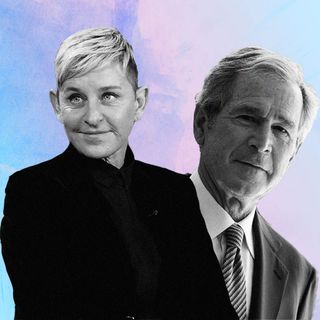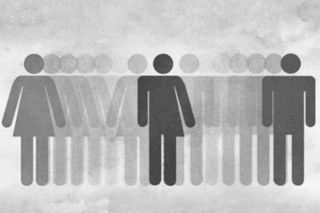
Explaining the Vocabulary of the Gender Spectrum
What it means to be trans, non-binary and gender non-conforming — or even everything at once.

As we create space for queer voices in mainstream culture, the language of sex and gender becomes imperative for everyone to understand. The basic aspects of sexual orientation and gender identity include what gender one identifies with (man, woman, somewhere in between or neither); what gender expression they choose to present to the world (masculine, feminine or non-binary); the sex they’re assigned at birth (male, female, intersex); and their sexual and romantic inclinations (gay, lesbian, bisexual, pansexual, asexual). All of these exist on a wide spectrum and can be fluid — not everyone adheres to one identity or expression all of their lives.
These five aspects of one’s sexuality and gender can be varied and not necessarily match traditional gender norms — an individual can be a trans woman, express as masculine, have male genitalia and be sexually attracted to non-binary people.
Everyone needs to understand the these complexities of gender identity — as Vera Papisova in Teen Vogue writes, “…we should really all be fluent in gender, because it helps all of us understand our own identities better.”
Gender identity
The Human Rights Campaign defines gender identity as “one’s innermost concept of self as male, female, a blend of both or neither – how individuals perceive themselves and what they call themselves. One’s gender identity can be the same or different from their sex assigned at birth.”
Cisgender
Cisgender people are those whose gender identity corresponds to the sex they were assigned at birth — a person born male identifies as a man; a person born female identifies as a woman.
Transgender
Transgender people are those who identify with a different gender than what is conventionally linked to the sex they were assigned at birth. Identifying as trans is not contingent upon getting a sex reassignment surgery (SRS) — gender identity is innate and doesn’t need to be proven through surgery or any psychological evaluation (as India’s latest trans rights bill would have you believe).
It was only in May 2019 that the World Health Organisation stopped categorizing being transgender as a mental health and behavioral disorder; what trans folks can suffer from is not a mental illness, but emotional distress stemming from not having their gender and assigned sex aligned — a state called gender dysphoria. Being trans is not something to be fixed, but many can opt to seek help for their gender dysphoria. Some trans people undergo surgery to have their gender and sex align; some don’t — for a variety of reasons, including lack of access to proper health care or simply because they choose not to.
Non-binary
Anyone whose gender identity can’t be categorized into man or woman can be non-binary. Within the non-binary gender identity, a person can be trans, i.e. their sex assigned at birth doesn’t match their gender identity, and still be non-binary, i.e. the gender they identify with doesn’t neatly fit into the man/woman binary.
Non-binary is an umbrella term — this can mean a person’s gender identity either lies somewhere between man and woman on the gender spectrum, or that it fluctuates back and forth from man to woman, or that it exists completely outside of the man-woman binary. For example, an agender person is someone who doesn’t identify with any gender. An androgyne person identifies with a gender identity somewhere in the middle between man and woman. Other terms people use to describe non-binary gender identities include genderqueer, bigender (someone who identifies with two distinct genders at a time — not necessarily 50-50 — such as man/woman, or woman/androgyne), gender-neutral, and gender fluid (someone who fluctuates between gender identities and considers their identity a spectrum). Not all, however, would use the term ‘non-binary’ to describe themselves.
A gender identity that falls outside of the man/woman binary is for the individual to determine — and they can use either of these terms based on their own interpretation and experience. Non-binary identities can also be fixed or fluid, as in, people can experience their gender either as a constant, or identify one way only some of the time, or identify in more than one way at a time. A good rule of thumb is to just ask how a person identifies and respect their answer.
Related on The Swaddle:
Gender and Sexuality Terms: A Sensitive Glossary For Parents
Gender expression
According to the Gender Spectrum, gender expression “is the way we communicate our gender to others through such things as clothing, hairstyles, and mannerisms. It also includes how individuals, communities and society perceive, interact with, and try to shape our gender. [Under the umbrella of] social gender, [it] includes gender roles and expectations and how society uses those to try to enforce conformity to current gender norms.”
Gender identity is not to be confused with gender expression — a person can identify with one gender and express another. For instance, a transgender person doesn’t necessarily have to conform to a binary of gender expression; they can choose to present themselves to others however they like — as masculine, feminine, somewhere in between, or neither, regardless of if they identify as a trans man, trans woman or a trans non-binary person.
Masculine/Feminine gender expression
For cisgender, heterosexual people gender expression often falls into the masculine/feminine binary — men look and act masculine, women look and act feminine. Masculine and feminine are often pre-determined gender expressions, which are taught to kids in a heteronormative way that reinforce (often oppressive) gender roles — men don’t cry, women are emotional; men don’t wear skirts, women do; and so on. Of course, what an individual picks and chooses from this preset pool of characteristics is up to them, and how they decide to portray themselves is their own prerogative. Cis-het identities, however, haven’t been stigmatized in society, which makes picking and choosing their gender expressions easier.
For queer people, certain gender expressions are automatically, stereotypically labeled as queer. People ascribe certain gender expressions to queer people, or think ‘being gay’ looks a certain way — such as the stereotypes that lesbians look masculine, or that gay men are more effeminate. To counter these stereotypes, masculine or feminine gender expressions within queer identities often manifest in a more determined and selective way — a different set of terms have evolved within queer spaces to communicate one’s gender expression — masc and femme, and gender non-conforming.
Femme
“A femme lesbian is typically left of center and presents as or identifies with femininity more so than masculinity or androgyny (a combination of masculinity and femininity in an ambiguous form),” Maya M. writes for Bustle. “There is also a sense of reclamation when it comes to the femme descriptor. For many, it’s about owning the stereotypes and expectations so often placed on women and making them our own,” Gina Tonic writes for Bustle. Femme gender expression is more about choosing the aspects of traditional femininity that correlate to individual personalities, and rejecting the rest. Tonic adds, “all femmes hit upon two key aesthetic and identity-related traits: Being feminine and falling somewhere on the LGBTQ spectrum.”
Masc
For masc gender expressions, the term butch is often used to refer to someone who exhibits certain masculine characteristics, such as wearing traditionally men’s clothes or having short hair. The difference between masc and masculine, however, is the same as the difference between femme and feminine — masc doesn’t necessarily correspond to traditional masculinity and incorporates a gender expression of masculinity as interpreted by the individual. It’s often used for masculine-presenting queer women.
Gender noncomformity
The terms we use to describe masculine or feminine gender expressions can also be used by people whose gender expression doesn’t necessarily match the gender they identify with or the gender that corresponds to the sex they were assigned at birth. For example, a non-binary person can exhibit masculine or feminine characteristics and/or identify as masc or femme.
Many transgender people conform to masculine or feminine gender expressions depending on the gender they identify with, but many also don’t. A transgender person who was assigned male at birth, for example, can choose to express feminine characteristics and describe themselves as transfeminine — regardless of whether they identify as a trans woman or not.
On the flip side, just because a person expresses their gender in a way that is outside of the masculine/feminine binary, doesn’t make them a transgender person — this is a term linked to gender identity, which doesn’t necessarily have to inform or reflect a person’s gender expression. For example, a cisgender man (whose gender aligns with the sex he was assigned at birth) who cross-dresses (wears clothes and accessories that are traditionally not worn by men) is not transgender but may be gender non-conforming, as his gender expression doesn’t conform to the traditional expectations associated with his gender — man.
Gender nonconformity can also exist outside the masculine/feminine binary — non-binary is also a term that can be used to describe gender expression, wherein an individual either expresses their gender somewhere between the masculine/feminine binary, expresses both at the same time, or expresses completely outside of it.
Gender-nonconforming as a label, however, should only be used if a person describes themselves as such.
Gender pronouns
Onto pronouns — they’re how a person likes to be referred to. While a tiny part of gender expression, pronouns signal to others how a person either identifies or expresses their gender. Pronouns not only don’t have to fit into a binary (he/him, she/her), they also don’t have to correspond to pronouns normally associated with one’s gender identity. For example, you can be a trans non-binary person and prefer gender-neutral pronouns such as xie/xir, zie/zir, and sie/hir.
However, not all people who identify or express as non-binary will prefer gender-neutral pronouns; they could very well ask to be referred to within the man/woman binary and prefer she/her or he/him. Again, a good rule of thumb is to ask and not assume.
The moral of the story is that gender identity and gender expression is a spectrum — where or whether one stands inside this spectrum is literally nobody’s business but the individual’s. It’s only for the individual to determine how they identify and how they express their gender; it’s also up to them to determine the vocabulary they use to communicate those aspects of themselves.
Rajvi Desai is The Swaddle's Culture Editor. After graduating from NYU as a Journalism and Politics major, she covered breaking news and politics in New York City, and dabbled in design and entertainment journalism. Back in the homeland, she's interested in tackling beauty, sports, politics and human rights in her gender-focused writing, while also co-managing The Swaddle Team's podcast, Respectfully Disagree.
Related


Little Big Things: The 42‑Year‑Old Paranormal Investigator and Demonologist
